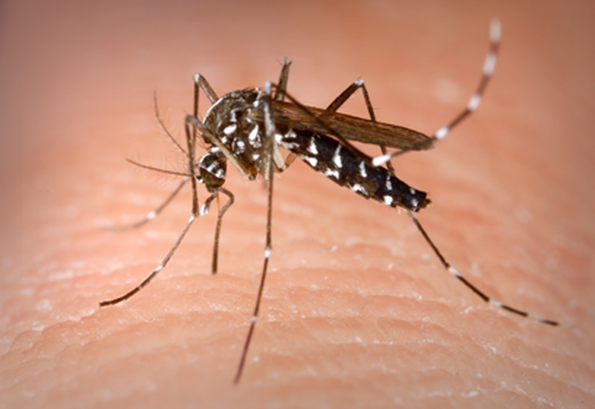|
Dr. Paul Leisnham has spent much of his career studying invasive, medically important mosquitoes in the United States. He has a long-term interest in their population dynamics, competition between invaders and natives, spatial patterns of invasion, and the influence of climate change on all of these interactions. And with good reason, as Dr. Leisnham explained, mosquitoes are well-documented vectors for a number of different diseases, including West Nile Virus, which hit peak frequencies in the U.S. in 2003 and more recently in 2012. Dr. Leisnham went on to describe that many of the diseases vectored by mosquitoes have no vaccine, making the presence of adults a greater health risk. For this reason, effective management happens by targeting the aquatic larvae, rather than the terrestrial adults. Mosquito larvae utilize a number of different habitats, ranging from ponds and wetlands to birdbaths and discarded tires filled with water. Dr. Leisnham argues that these small containers may actually be one of the most important sources of mosquitoes found in urban and suburban areas. or this reason, Dr. Leisnham became interested in the role of residents in managing local populations of mosquitoes. With so many potential habitats for larvae in the backyard of an average Washington D.C. resident, Dr. Leisnham posited that resident source reduction would be critical for successful management of mosquito populations. That left him with important questions about the attitudes and knowledge of Washington D.C. residents towards mosquitoes and their management in urban settings. Working with former master’s student Zara Dowling, Dr. Leisnham designed a survey to address the following questions: 1) Can residents reduce mosquito populations? 2) Is mosquito reduction related to the attitude of the residents? and 3) Do the residents’ level of knowledge change their attitude toward reduction? A survey of 240 households in the D.C. area was conducted by Dr. Leisnham’s lab to address these questions. The results showed that younger, higher income residents had the most general knowledge about mosquitoes, while older, male residents knew the most about mosquitoes’ larval habitat. By comparison, lower income women were the most motivated to control mosquito populations. The data also indicated that, although resident source reduction may be important, the efforts of knowledgeable residents may be rendered ineffective by residents who are not removing container habitats from their property. Based on these results, Dr. Leisnham then designed the Tip N Trash Program, with the goal of evaluating the success of passive educational materials for effecting resident source reduction. With the help of students, Dr. Leisnham designed and circulated educational materials, including magnets and flyers, to the same 240 households used in the survey the year before. Preliminary results from this research suggest that passive educational materials have limited success. So far, Dr. Leisnham has identified an overall improvement in knowledge and attitude of residents that corresponds with education, but this has not yet translated into source reduction. Surveys of mosquito populations in this year also indicated that residents may be missing key containers where mosquitoes breed, negating the effects of source reduction. Since beginning this line of inquiry, Dr. Leisnham has become increasingly interested in the sociological implications of his research. He plans to continue his investigation into the role of residents in mosquito management and the effectiveness of different educational tools for engaging citizen participation. He also wants to further understand the macro- and micro-scale patterns of larval mosquito occurrence that may explain overall trends in population abundance. Dr. Leisnham’s research has important implications for human health and for understanding population dynamics of invasive species; you can keep track of his research to learn more! Further Reading: 1. Dowling, Z.*, P. Armbruster, S. LaDeau, and P.T Leisnham. 2013. Socioeconomic status affects mosquito (Diptera: Culicidae) larval habitat with implications for vector control. Journal of Medical Entomology. In Press. 2. Smith, C. D.*, A. H. Baldwin, J. Sullivan, and P. T. Leisnham. 2013. Effects of elevated atmospheric CO2 on competition between the mosquitoes Aedes albopictus and Ae. triseriatus through changes in litter quality and production. Journal of Medical Entomology 50: 521-532; DOI: http://dx.doi.org/10.1603/ME12149. About Elanor:
Elanor Spadafora is a fourth year PhD student studying the influence of vegetation on predaceous diving beetle communities (Coleoptera: Dytiscidae) in restored and historic wetlands on the Delmarva Peninsula. She uses functional traits and behavioral studies to understand how these beetles interact with aquatic macrophytes and how this may influence trophic structure. Comments are closed.
|
Categories
All
Archives
June 2024
|
Department of Entomology
University of Maryland
4112 Plant Sciences Building
College Park, MD 20742-4454
USA
Telephone: 301.405.3911
Fax: 301.314.9290
University of Maryland
4112 Plant Sciences Building
College Park, MD 20742-4454
USA
Telephone: 301.405.3911
Fax: 301.314.9290



 RSS Feed
RSS Feed




